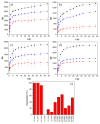Hybrid Methacrylated Gelatin and Hyaluronic Acid Hydrogel Scaffolds. Preparation and Systematic Characterization for Prospective Tissue Engineering Applications
- PMID: 34201769
- PMCID: PMC8268476
- DOI: 10.3390/ijms22136758
Hybrid Methacrylated Gelatin and Hyaluronic Acid Hydrogel Scaffolds. Preparation and Systematic Characterization for Prospective Tissue Engineering Applications
Abstract
Hyaluronic acid (HA) and gelatin (Gel) are major components of the extracellular matrix of different tissues, and thus are largely appealing for the construction of hybrid hydrogels to combine the favorable characteristics of each biopolymer, such as the gel adhesiveness of Gel and the better mechanical strength of HA, respectively. However, despite previous studies conducted so far, the relationship between composition and scaffold structure and physico-chemical properties has not been completely and systematically established. In this work, pure and hybrid hydrogels of methacroyl-modified HA (HAMA) and Gel (GelMA) were prepared by UV photopolymerization and an extensive characterization was done to elucidate such correlations. Methacrylation degrees of ca. 40% and 11% for GelMA and HAMA, respectively, were obtained, which allows to improve the hydrogels' mechanical properties. Hybrid GelMA/HAMA hydrogels were stiffer, with elastic modulus up to ca. 30 kPa, and porous (up to 91%) compared with pure GelMA ones at similar GelMA concentrations thanks to the interaction between HAMA and GelMA chains in the polymeric matrix. The progressive presence of HAMA gave rise to scaffolds with more disorganized, stiffer, and less porous structures owing to the net increase of mass in the hydrogel compositions. HAMA also made hybrid hydrogels more swellable and resistant to collagenase biodegradation. Hence, the suitable choice of polymeric composition allows to regulate the hydrogels´ physical properties to look for the most optimal characteristics required for the intended tissue engineering application.
Keywords: gelatin; hyaluronic acid; hybrid scaffolds; hydrogel; porosity; tissue engineering.
Conflict of interest statement
The authors declare no conflict of interest.
Figures












Similar articles
-
Synthesis and characterization of hybrid hyaluronic acid-gelatin hydrogels.Biomacromolecules. 2013 Apr 8;14(4):1085-92. doi: 10.1021/bm3019856. Epub 2013 Mar 28. Biomacromolecules. 2013. PMID: 23419055 Free PMC article.
-
Gelatin methacrylate scaffold for bone tissue engineering: The influence of polymer concentration.J Biomed Mater Res A. 2018 Jan;106(1):201-209. doi: 10.1002/jbm.a.36226. Epub 2017 Sep 28. J Biomed Mater Res A. 2018. PMID: 28884519
-
Synthesis, properties, and biomedical applications of gelatin methacryloyl (GelMA) hydrogels.Biomaterials. 2015 Dec;73:254-71. doi: 10.1016/j.biomaterials.2015.08.045. Epub 2015 Aug 28. Biomaterials. 2015. PMID: 26414409 Free PMC article. Review.
-
Optimizing the composition of gelatin methacryloyl and hyaluronic acid methacryloyl hydrogels to maximize mechanical and transport properties using response surface methodology.J Biomed Mater Res B Appl Biomater. 2023 Mar;111(3):526-537. doi: 10.1002/jbm.b.35169. Epub 2022 Oct 21. J Biomed Mater Res B Appl Biomater. 2023. PMID: 36269163 Free PMC article.
-
Gelatin Methacrylate (GelMA)-Based Hydrogels for Cell Transplantation: an Effective Strategy for Tissue Engineering.Stem Cell Rev Rep. 2019 Oct;15(5):664-679. doi: 10.1007/s12015-019-09893-4. Stem Cell Rev Rep. 2019. PMID: 31154619 Review.
Cited by
-
Hyaluronic Acid Scaffolds for Loco-Regional Therapy in Nervous System Related Disorders.Int J Mol Sci. 2022 Oct 12;23(20):12174. doi: 10.3390/ijms232012174. Int J Mol Sci. 2022. PMID: 36293030 Free PMC article. Review.
-
Advanced PEG-tyramine biomaterial ink for precision engineering of perfusable and flexible small-diameter vascular constructs via coaxial printing.Bioact Mater. 2024 Mar 5;36:168-184. doi: 10.1016/j.bioactmat.2024.02.019. eCollection 2024 Jun. Bioact Mater. 2024. PMID: 38463551 Free PMC article.
-
Controlled PVA Release from Chemical-Physical Interpenetrating Networks to Treat Dry Eyes.ACS Omega. 2024 Dec 21;10(1):1249-1260. doi: 10.1021/acsomega.4c08667. eCollection 2025 Jan 14. ACS Omega. 2024. PMID: 39829547 Free PMC article.
-
Ascorbyl palmitate nanofiber-reinforced hydrogels for drug delivery in soft issues.Commun Mater. 2024;5(1):197. doi: 10.1038/s43246-024-00641-x. Epub 2024 Sep 20. Commun Mater. 2024. PMID: 39309138 Free PMC article.
-
Improving Antimicrobial Properties of GelMA Biocomposite Hydrogels for Regenerative Endodontic Treatment.Polymers (Basel). 2024 Jun 12;16(12):1675. doi: 10.3390/polym16121675. Polymers (Basel). 2024. PMID: 38932026 Free PMC article.
References
MeSH terms
Substances
Grants and funding
- PID2019-109517RB-I00,/Agencia Estatal de Investigación
- MAT2016-8266R/Agencia Estatal de Investigación
- ED431C 2018/26/Consellería de Cultura, Educación e Ordenación Universitaria, Xunta de Galicia
- ED431C 2020/17/Consellería de Cultura, Educación e Ordenación Universitaria, Xunta de Galicia
- ISPP-144/International Scientific Partnership Program ISSP at King Saud University
LinkOut - more resources
Full Text Sources

